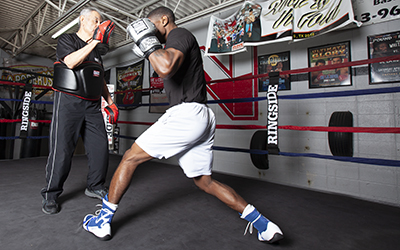
Introduced relatively recently, Punch Mitts have become a critical training tool for coaches and fighters throughout the boxing and martial arts world.
But you can’t just hang Punch Mitts from the ceiling. Someone has to hold them for a fighter. And that someone could be you.
If you want to learn the art of properly holding those mitts, then read on. We put together a list of seven fundamentals for creating a great mitt-work experience.
1. Discuss Goals/Plan with Puncher
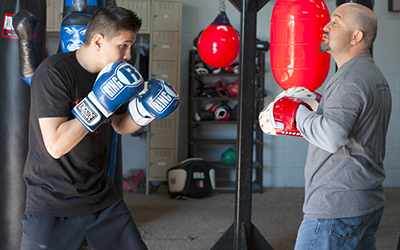
As we’ve discussed before, you need to have specific goals when heading into training sessions like this. Unlike heavy bag work, Punch Mitts offer the fighter a lot of different options. Will you focus on rhythm and accuracy, reaction drills, maintaining defense, or simulating an upcoming opponent?
Knowing what you and your partner want to accomplish with this training, sets the tone for how you work the mitts.
Since this is a partner training drill, though, you have to make sure that you discuss this plan with your partner. The fighter you work with needs to know what to expect from the training session to get the most from it.
2. Position the Mitts Properly
Punch Mitt training should help a fighter prepare for an actual match. So, when you hold the mitts, they need to simulate punching an opponent as much as possible.
Keep the mitts close in to your body’s silhouette. You might feel more comfortable with the mitts nowhere near your face or body, but that won’t provide your fighter the best training. And always keep your elbows in close to your body.
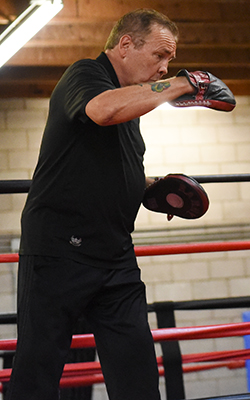
For straight punches, keep the mitts at about forehead height, just to the left or right of your head, and a few inches in front of you. The mitts should be angled inward slightly.
For hooks, turn the pad inward so that it is almost perpendicular to your body. Hold it at about eye-height for head shots or at rib height for body shots.
For uppercuts, the pad should face the ground, though you can angle it up slightly. Hold it about chin height.
3. Push Back Against the Punch
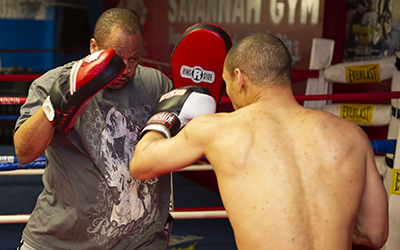
You don’t want to just hold your arm up limply and wait for the pad to get hit. That will send your arm flying all over the place, strain your elbow and shoulder, and put unnecessary stress on the fighter’s joints as well.
When holding the mitts, you need to provide resistance to every hit. The easiest way to accomplish this? Push back against the punch as it comes in to meet the mitt. This could mean moving toward the glove by up to an inch or two to close that distance.
Pushing back against the punch will help protect everyone’s joints. It also provides the fighter with tactile feedback and helps you develop a rhythm for the mitts.
4. Get into a Natural Fighting Stance
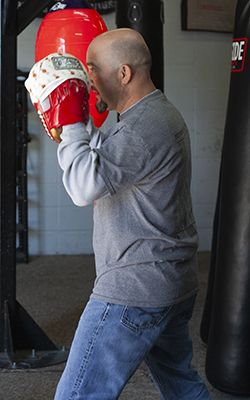
When you hold the Punch Mitts for someone you don’t just use your hands and arms. When you throw punches, you use your whole body. The same is true for when you catch punches.
Make sure that you are prepared by getting into a comfortable fighting stance. You should be well-balanced and braced for impact for each punch. A fighting stance gives you that stability, while leaving you the flexibility to easily move in any direction.
5. Make your Fighter Move
The fact that you can move around the ring sets you apart from a stationary device like a heavy bag or wall bag. So USE that ability.
Once you and your fighter feel warmed up and comfortable, use your feet to force your fighter to use theirs. You have the entire ring and the entire gamut of footwork options to choose from, so mix it up. Start by working your way forward to force your fighter to back up. Then swing out to the side, to get your fighter to pivot. Back up and get your fighter to advance.
Remember, you set the tone here, so find ways to get your fighter to use all their movement abilities.
6. Give Feedback
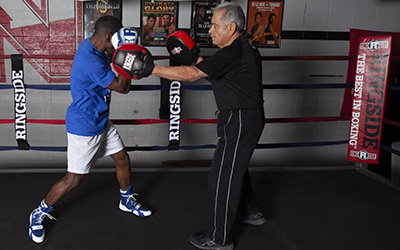
You don’t want to spend an entire session on the pads telling your partner everything you see. For the most part, any observations or recommendations can wait until the end of the session.
But you can work feedback into the session as things come up.
The fact that you can reach out and tap your fighter with the Mitt will help correct certain defensive shortcomings more than endlessly chanting, “Keep your guard up!”. When you see it, tap them.
Because you control the flow of the session, you also have the ability to focus in on areas that appear to need extra work. For example, if your fighter struggles to land a particular combination or transition, you can focus in on that issue. Run through those exercises for a while until you feel ready to move on.
7. Adjust your Speed
More than anything else, you control the challenge level of mitt session by controlling the speed. So make use of that control throughout the session.
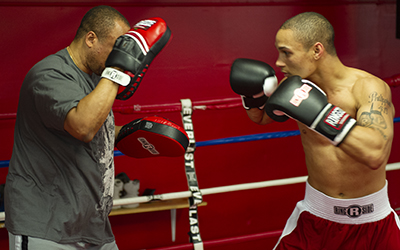
Start things off slow, to get you both warmed up. This also allows you to make adjustments to your distance and positioning. When you are both ready, then take it up to whatever you have established as “full-speed” for the two of you.
As training continues, you may find your fighter needs more of a challenge in some areas, and more development in others. Adjust the speed, up or down, as necessary to keep the workout just challenging enough to be valuable, but not so challenging that it becomes frustrating.
Conclusion
If you follow these seven tips, then you can give your training partner a great experience on the mitts. Don’t worry if you don’t get it all perfect right out of the gate. Perfecting your mitt holding ability take time and experience–just like punching. But once you dial in the feel for it, you will become an invaluable training partner for anyone at your gym.


You didn’t mention that the jab and straight right hit the same pad. I see many people jabbing at the mitt holder’s left and the straight right hits the right mitt. When throwing the combination of the jab-straight right; the jab barely touches the mitt followed very quickly with the straight right. The jab needs only to block the view of your opponent so the right hand with power lands a split second after.
Exactly…
All good tips save for the part about pushing the mitts back on a would be boxer. Boxing is already a watered sport from what it once used to be. Position the mitts, brace for the punches, but my motto is let the punchers punch. Too many coaches are slapping mitts on boxers i. e. pushing them and boxers don’t rotate their shoulders fully because of the simple fact that the punch mitts or punch paddles are meeting the punches halfway. This leaves your solar plex in a compromising position . Canelo’s coaching staff is a perfect example . You can learn to position and then steady the punch mitts or paddles without creating joint issues to then allow the boxer to fully rotate setting up the next punch in maximum fashion. Learning to fully rotate will also help boxers to learn to roll punches better from a defensive standpoint which is another Lost Art because in a technical sense offensive and defensive position or movement is relatively the same in terms of throwing punches. I just see so many coaches doing more than their boxer is doing during a workout so giving them the impression in any type of way that they can push back would take away further from the boxers workout as well as technical development. I also teach students to hold mitts because what in fact they are doing is learning to catch punches and or defend themselves.
This is actually a great point, and I’m sorry it didn’t come through better in the blog. When we say push back, we’re really talking about pushing back against the punch at the moment of contact or a split second before. This shouldn’t be more than an inch or so of movement. It’s tensing up those muscles to provide a solid target for the fighter support the joints for the trainer.
One of the things I hate to see in training videos is when the training partner moves the mitt like a foot to slap the fighter’s glove. It looks great on camera for Mayweather’s media day before a fight, but it’s garbage for most training.
I always hated that… mitt holder punching the mitts at me just as hard as I’m punching at him.
Strongly agree! Thank you for clarification.
Great article
punch mitt workouts are actually the only form of a routine that is the closest thing to boxing with an opponent without the risk of taking punches in return and essential in proper training. The input and “tips” offered were priceless, especially to new or coaches that are just starting to introduce this type of preparation regarding their training techniques. Thank You, Thomas Emerson Smith (former coach for over 40 plus years)
Not to sound like an expert, i am NOT!,.. but the weight of the ‘mitt’ is important: the bigger and heavier the mitt, the slower the drill and more wear and tear on the trainer! Have fun!
Be on the same page. Something should be said about calling-out the punches and combinations that are to be thrown,not just mit positioning but verbal instructions ;the talk of punches and punching
This is part of that first planning step. For some training, especially for fighters learning a new combination or just getting started with Mitt work, calling out the punches should be part of the exercise. But if your goal is to help a fighter work on reactions and learning to “see” the targets in the ring, you want to minimize how much you’re calling out. Because when it comes to a fight, you won’t be standing over your fighter’s shoulder calling out the punches.
So when you work on planning out the exercise beforehand, decide how much calling-out will be appropriate based on training goals. And it could be that you adjust this as the training moves forward. A lot of call outs for the first round with almost no call-outs by the final round.
Awesome advise